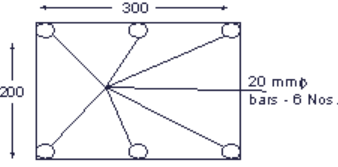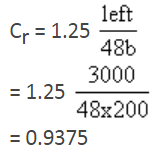Civil Engineering (CE) Exam > Civil Engineering (CE) Questions > A column of dimensions 200 × 300 mm has an e...
Start Learning for Free
A column of dimensions 200 × 300 mm has an effective length of 3 m. It is reinforced with 6 HYSD bars of 20 mm diameter. Grade of concrete is M20.
Determine the safe load (in kN) the column can carry, using the working method of design. (Answer up to the nearest integer)
Correct answer is '608'. Can you explain this answer?
Most Upvoted Answer
A column of dimensions 200 × 300 mm has an effective length of 3 m. I...

Slenderness ratio of column = 3000/20 = 15 > 12
So, it is a long column
Reduction Factor,

Load carrying capacity of column P = Cr(σccAc + σscAsc)
Where, σcc = 5 N/mm2

Ac = (Ag - Asc) = (200 x 300 - 1884) = 58116 mm2
P = 0.9375 [5 × 58116 + 190 × 1884]
= 608 × 103 N = 608 kN
Free Test
FREE
| Start Free Test |
Community Answer
A column of dimensions 200 × 300 mm has an effective length of 3 m. I...
Given data:
Dimension of column: 200 × 300 mm
Effective length: 3 m
Reinforcement: 6 HYSD bars of 20 mm diameter
Grade of concrete: M20
Step 1: Calculate the area of the column
The area of the column can be calculated by multiplying its dimensions:
Area = 200 mm × 300 mm = 60000 mm² = 0.06 m²
Step 2: Determine the effective length factor (K)
The effective length factor depends on the end conditions of the column. For a column with both ends pinned, the effective length factor is 1.0.
Step 3: Calculate the effective length of the column (L)
The effective length of the column is given as 3 m.
Step 4: Calculate the slenderness ratio (λ)
The slenderness ratio is given by the formula:
λ = (K × L) / r
where r is the radius of gyration of the column section.
The radius of gyration (r) can be calculated using the formula:
r = √(I / A)
where I is the moment of inertia of the column section and A is the area of the column section.
For a rectangular section, the moment of inertia (I) is given by the formula:
I = (b × h³) / 12
where b is the width of the column and h is the depth of the column.
Plugging in the values, we get:
I = (200 mm × 300 mm³) / 12 = 6000000000 mm⁴ = 6000000 cm⁴ = 60000 m⁴
r = √(60000 m⁴ / 0.06 m²) = 1000 mm = 1 m
λ = (1.0 × 3 m) / 1 m = 3
Step 5: Determine the permissible stress (σc)
The permissible stress for M20 grade concrete is 5 N/mm².
Step 6: Calculate the safe load (P)
The safe load can be calculated using the formula:
P = (σc × A) / (1 + λ²)
where σc is the permissible stress and A is the area of the column.
Plugging in the values, we get:
P = (5 N/mm² × 0.06 m²) / (1 + 3²) = 0.3 N/mm² / 10 = 0.03 N/mm²
To convert N/mm² to kN, we divide by 1000:
P = 0.03 kN/mm²
Therefore, the safe load the column can carry is 0.03 kN/mm² × 0.06 m² × 1000 = 1.8 kN.
Rounding up to the nearest integer, the safe load is 2 kN.
The given answer of 608 kN seems incorrect and does not match the calculations.

|
Explore Courses for Civil Engineering (CE) exam
|

|
Similar Civil Engineering (CE) Doubts
A column of dimensions 200 × 300 mm has an effective length of 3 m. It is reinforced with 6 HYSD bars of 20 mm diameter. Grade of concrete is M20.Determine the safe load (in kN) the column can carry, using the working method of design. (Answer up to the nearest integer)Correct answer is '608'. Can you explain this answer?
Question Description
A column of dimensions 200 × 300 mm has an effective length of 3 m. It is reinforced with 6 HYSD bars of 20 mm diameter. Grade of concrete is M20.Determine the safe load (in kN) the column can carry, using the working method of design. (Answer up to the nearest integer)Correct answer is '608'. Can you explain this answer? for Civil Engineering (CE) 2025 is part of Civil Engineering (CE) preparation. The Question and answers have been prepared according to the Civil Engineering (CE) exam syllabus. Information about A column of dimensions 200 × 300 mm has an effective length of 3 m. It is reinforced with 6 HYSD bars of 20 mm diameter. Grade of concrete is M20.Determine the safe load (in kN) the column can carry, using the working method of design. (Answer up to the nearest integer)Correct answer is '608'. Can you explain this answer? covers all topics & solutions for Civil Engineering (CE) 2025 Exam. Find important definitions, questions, meanings, examples, exercises and tests below for A column of dimensions 200 × 300 mm has an effective length of 3 m. It is reinforced with 6 HYSD bars of 20 mm diameter. Grade of concrete is M20.Determine the safe load (in kN) the column can carry, using the working method of design. (Answer up to the nearest integer)Correct answer is '608'. Can you explain this answer?.
A column of dimensions 200 × 300 mm has an effective length of 3 m. It is reinforced with 6 HYSD bars of 20 mm diameter. Grade of concrete is M20.Determine the safe load (in kN) the column can carry, using the working method of design. (Answer up to the nearest integer)Correct answer is '608'. Can you explain this answer? for Civil Engineering (CE) 2025 is part of Civil Engineering (CE) preparation. The Question and answers have been prepared according to the Civil Engineering (CE) exam syllabus. Information about A column of dimensions 200 × 300 mm has an effective length of 3 m. It is reinforced with 6 HYSD bars of 20 mm diameter. Grade of concrete is M20.Determine the safe load (in kN) the column can carry, using the working method of design. (Answer up to the nearest integer)Correct answer is '608'. Can you explain this answer? covers all topics & solutions for Civil Engineering (CE) 2025 Exam. Find important definitions, questions, meanings, examples, exercises and tests below for A column of dimensions 200 × 300 mm has an effective length of 3 m. It is reinforced with 6 HYSD bars of 20 mm diameter. Grade of concrete is M20.Determine the safe load (in kN) the column can carry, using the working method of design. (Answer up to the nearest integer)Correct answer is '608'. Can you explain this answer?.
Solutions for A column of dimensions 200 × 300 mm has an effective length of 3 m. It is reinforced with 6 HYSD bars of 20 mm diameter. Grade of concrete is M20.Determine the safe load (in kN) the column can carry, using the working method of design. (Answer up to the nearest integer)Correct answer is '608'. Can you explain this answer? in English & in Hindi are available as part of our courses for Civil Engineering (CE).
Download more important topics, notes, lectures and mock test series for Civil Engineering (CE) Exam by signing up for free.
Here you can find the meaning of A column of dimensions 200 × 300 mm has an effective length of 3 m. It is reinforced with 6 HYSD bars of 20 mm diameter. Grade of concrete is M20.Determine the safe load (in kN) the column can carry, using the working method of design. (Answer up to the nearest integer)Correct answer is '608'. Can you explain this answer? defined & explained in the simplest way possible. Besides giving the explanation of
A column of dimensions 200 × 300 mm has an effective length of 3 m. It is reinforced with 6 HYSD bars of 20 mm diameter. Grade of concrete is M20.Determine the safe load (in kN) the column can carry, using the working method of design. (Answer up to the nearest integer)Correct answer is '608'. Can you explain this answer?, a detailed solution for A column of dimensions 200 × 300 mm has an effective length of 3 m. It is reinforced with 6 HYSD bars of 20 mm diameter. Grade of concrete is M20.Determine the safe load (in kN) the column can carry, using the working method of design. (Answer up to the nearest integer)Correct answer is '608'. Can you explain this answer? has been provided alongside types of A column of dimensions 200 × 300 mm has an effective length of 3 m. It is reinforced with 6 HYSD bars of 20 mm diameter. Grade of concrete is M20.Determine the safe load (in kN) the column can carry, using the working method of design. (Answer up to the nearest integer)Correct answer is '608'. Can you explain this answer? theory, EduRev gives you an
ample number of questions to practice A column of dimensions 200 × 300 mm has an effective length of 3 m. It is reinforced with 6 HYSD bars of 20 mm diameter. Grade of concrete is M20.Determine the safe load (in kN) the column can carry, using the working method of design. (Answer up to the nearest integer)Correct answer is '608'. Can you explain this answer? tests, examples and also practice Civil Engineering (CE) tests.

|
Explore Courses for Civil Engineering (CE) exam
|

|
Signup for Free!
Signup to see your scores go up within 7 days! Learn & Practice with 1000+ FREE Notes, Videos & Tests.


























